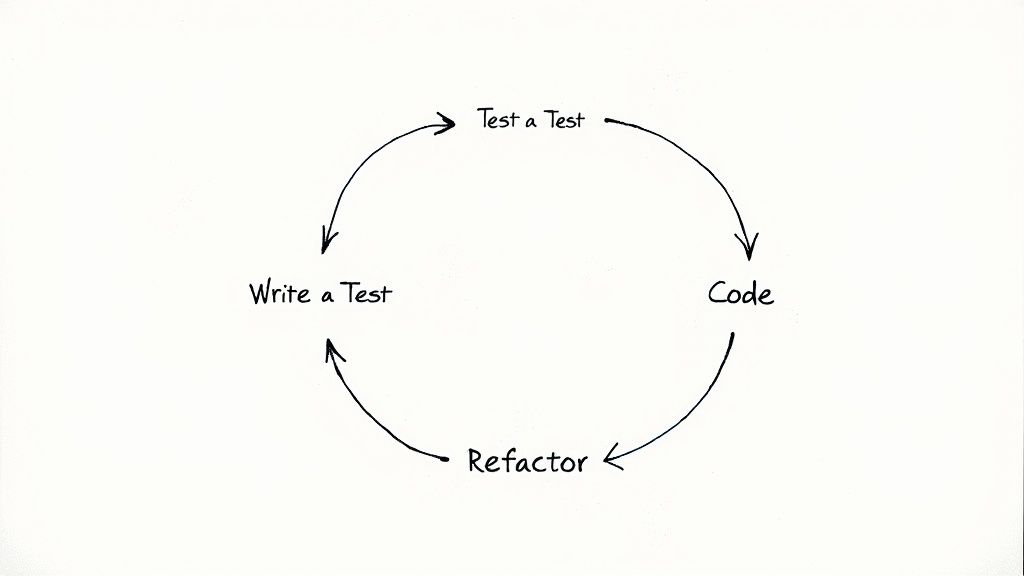What is Test-Driven Development (TDD)? A Practical Guide for Modern Developers

Test-driven development (TDD) represents a powerful shift in software development practices. At its core, TDD follows a simple but effective pattern called "red, green, refactor" that helps developers build reliable code. The process starts by writing a failing test (red) for a specific feature you want to build. Next, you write just enough code to make that test pass (green). Once the test passes, you clean up and improve the code (refactor) while making sure the test still works.
The Red, Green, Refactor Cycle in Action
Let's look at a real-world example of how TDD works. Say you're building a calculator app and need to add multiplication. You'd begin by writing a test checking if multiplying 2 and 3 equals 6. This test fails at first since there's no multiplication function yet - that's your red phase. Then you'd write the basic multiplication code to pass that test - your green phase. Finally, you'd improve the code to handle special cases like multiplying by zero, always checking that your original test still passes. Through this process, every piece of new code is built on a foundation of working tests.
Common Misconceptions about TDD
Many people think TDD is just about writing tests before code, but its real value comes from the constant feedback it provides. Each test serves as a clear specification of what the code should accomplish. Studies from Microsoft and IBM have found this approach reduces bugs by 40-90%. While TDD requires more upfront work and may feel slower at first, experienced teams often find it speeds up development by catching issues early and reducing time spent fixing bugs. Tools like Mergify can help teams manage the workflow of frequent test-driven code changes more efficiently.
TDD and Modern Development Practices
TDD fits naturally with today's Agile and DevOps approaches. Its short cycles of writing tests, implementing features, and refactoring align perfectly with rapid development and continuous integration. The immediate feedback helps teams catch and fix problems quickly, enabling faster releases. Most importantly, the comprehensive test coverage that TDD creates gives developers confidence to improve and adapt their code as needs change. This results in software that's both reliable and able to evolve smoothly over time.
Real-World Impact on Code Quality

The benefits of test-driven development (TDD) are backed by hard data from industry leaders. Both Microsoft and IBM have conducted studies showing that teams using TDD experience 40-90% fewer bugs in their code. For development teams, this means more reliable software and less time fixing unexpected problems. Let's look at how TDD delivers these improvements in practice.
Reduced Defect Density: The Numbers Speak for Themselves
The dramatic drop in bug counts comes directly from TDD's core approach. When developers write tests first, they must clearly define how each function should behave before writing any code. This upfront clarity catches issues early - for example, a small error in a calculation function gets flagged immediately rather than causing problems throughout the system later. The tests act as an early warning system, preventing minor issues from growing into major headaches.
Beyond Bug Counts: The Impact on Maintainability and Development Speed
TDD also makes code easier to maintain over time. The test suite serves as clear documentation showing exactly how each piece of code should work. This helps new team members understand the codebase quickly and lets developers make changes confidently, knowing the tests will catch any unintended effects. As a result, the code stays healthy and manageable as the project grows.
While writing tests first might seem slower initially, it often speeds up development in the long run. With fewer bugs to fix later, teams spend less time debugging and more time building features. This is especially true for larger, more complex projects. Tools like Mergify help teams work efficiently with TDD by automating code integration in test-heavy environments. The time saved through early bug detection and better maintainability helps teams deliver reliable software faster. Given these clear benefits, the key question becomes: how can you effectively bring TDD into your current development process?
Making TDD Work in Your Workflow

Test-driven development (TDD) can significantly improve code quality when used effectively. Successfully adopting TDD requires more than just writing tests - it needs a thoughtful approach and consistent practice. Let's explore practical ways to make TDD work in your development process.
Starting Small: Writing Your First TDD Test
The best way to begin with TDD is to choose something simple and specific. Say you need to add a basic form validation rule - start by writing a test checking if the validation behaves as expected. When you first run this test, it will fail since you haven't written the actual validation code yet. This failure is exactly what you want - it confirms your test is working properly. Next, write just enough code to make the test pass. Once it passes, you can clean up and improve the code while ensuring the test continues to work.
Building Momentum: Maintaining TDD in Larger Projects
As projects grow larger, managing tests becomes more complex. Treat your test code with the same care as your production code - review it thoroughly and organize it well. Tools like Mergify can help streamline code reviews, especially for projects with many tests. Clear naming patterns and logical test organization make the test suite easier to maintain as it expands. Good structure helps teams stay consistent with TDD practices over time.
Integrating TDD into Existing Projects
Adding TDD to an established project takes patience. Start by using TDD for new features and bug fixes rather than trying to test everything at once. This lets the team practice TDD without disrupting current work. For older code without tests, focus first on testing critical sections and areas that change often. While complete test coverage isn't always practical or needed, prioritize testing the parts of your codebase where issues are most likely to appear.
Balancing Thoroughness and Speed
Many developers worry that TDD will slow them down. Research shows that while TDD may take more time upfront, it saves time later through fewer bugs and easier maintenance. The key is finding the right balance. Focus your testing on core functionality and likely problem areas rather than trying to test every possible scenario. This approach helps catch important issues while keeping development moving at a good pace. Remember that effective TDD isn't about hitting specific coverage numbers - it's about writing tests that genuinely improve your code quality.
Navigating the Learning Curve

Adopting test-driven development (TDD) requires a fundamental shift in how developers work. Writing tests before code feels strange at first and can make development seem slower initially. Let's explore the common challenges teams face when starting with TDD and practical ways to handle them.
Overcoming the Initial Productivity Dip
The most immediate challenge is feeling less productive at first. When you're used to diving straight into code, having to write tests first seems like extra work. This is completely normal - just like when you first learned to drive. At first, you had to think consciously about every movement. But after practice, driving became second nature, letting you focus on the road ahead. The same happens with TDD - while it takes time to adjust, developers often end up coding faster with tests than without them, thanks to fewer bugs and less time spent debugging.
Maintaining Momentum: Addressing Resistance to Change
Team members sometimes push back against TDD, seeing it as unnecessary overhead. The key is showing clear evidence of its benefits through real examples. For instance, companies like Microsoft and IBM have seen bug rates drop by 40-90% after implementing TDD. Sharing concrete results helps skeptical developers understand why the extra effort upfront pays off through better code quality and easier maintenance.
Building Sustainable TDD Habits
Making TDD stick requires the right tools and practices. For example, Mergify helps streamline code reviews and merges, which becomes especially important with TDD's frequent changes. Teams also need clear guidelines about test naming, organization, and what makes a good test. These shared standards help everyone write better tests more consistently.
Fostering Team Buy-In and Addressing Challenges
Open communication is essential for successful TDD adoption. Create space for the team to discuss what's working and what isn't. Regular check-ins help identify pain points early so you can adjust your approach. When team members feel comfortable asking questions and sharing experiences, they're more likely to embrace TDD fully. This combination of clear communication, practical tools, and steady practice helps teams get through the learning curve and realize the long-term benefits of test-driven development.
Measuring Success and ROI
Understanding how to measure test-driven development's impact is just as important as knowing how to implement it. To show TDD's real value and justify its investment, we need to look beyond simple metrics like test counts or code coverage. Let's focus on measuring TDD's concrete effects on your development process and the final product quality.
Key Metrics for Measuring TDD Success
When evaluating TDD's effectiveness, several key measurements can help paint a clear picture of your return on investment. Here are the most meaningful metrics to track:
-
Reduced Defect Rate: This is one of the most powerful indicators. Compare the number of bugs found before release in TDD projects versus non-TDD projects. Studies from Microsoft and IBM have shown 40-90% fewer bugs with TDD - these dramatic improvements directly translate to lower costs for debugging and fixes.
-
Faster Time to Market: Though writing tests first may seem slower initially, it often speeds up the overall development cycle. Finding and fixing issues early means less time spent on late-stage debugging. This faster delivery can give your team an edge in releasing new features.
-
Improved Code Maintainability: TDD naturally leads to cleaner, more modular code that's easier to work with over time. Monitor how long it takes to add features or fix issues in existing code. When these tasks start taking less time, it shows your codebase is becoming more manageable through TDD.
-
Increased Developer Confidence: When developers have a solid test suite backing their work, they can improve and refactor code without worrying about breaking things. While this is harder to measure directly, regular team feedback can reveal growing confidence levels and their impact on code quality.
Tracking TDD Metrics Effectively
To gather these metrics effectively, you need a systematic approach. Use tools that fit into your workflow and collect data automatically where possible. For instance, Mergify can help manage TDD's increased pull requests and code reviews while providing insights on merge times and code changes.
Start by establishing baseline measurements before implementing TDD. This gives you clear before-and-after comparisons to show TDD's impact. But don't just collect numbers - analyze them regularly and use those insights to improve your TDD practices. This continuous refinement helps maximize TDD's benefits and value.
Beyond the Numbers: Qualitative Benefits of TDD
While measurable metrics matter, don't overlook TDD's other valuable benefits. Better code quality, stronger team collaboration, and happier customers all contribute to TDD's overall value, even if they're harder to measure directly. By considering both hard numbers and these broader improvements, you'll get a complete picture of how TDD helps your team succeed.
Advanced TDD Strategies
As development teams master the basics of test-driven development (TDD), they often need more sophisticated approaches to tackle complex systems and mature codebases. Let's explore key strategies that help teams apply TDD effectively at scale.
Integrating with Behavior-Driven Development (BDD)
Combining TDD with Behavior-Driven Development (BDD) creates a powerful workflow that connects technical implementation to user needs. BDD describes system behavior in plain language that both developers and business stakeholders can understand. For example, a login feature might have this BDD scenario: "Given a valid username and password, when the user clicks 'login', then they should be redirected to the dashboard." Teams can use this scenario to guide their TDD tests, making sure the code matches intended behavior. Tools like Cucumber help manage these BDD scenarios and connect them to the underlying code.
Effective Mocking Practices
Testing complex systems requires careful isolation of code units. Mocking helps by replacing real dependencies with simulated objects, letting you focus on testing specific components. This prevents test failures from cascading and makes it easier to find the source of problems. For instance, when testing code that needs database access, using a mock database lets you verify the logic without requiring an actual database connection. This approach leads to faster, more reliable tests.
Managing Test Suites at Scale
Large projects often struggle with growing test suites. Teams need strategies to keep tests fast and dependable for effective TDD. Good practices include grouping tests by feature, using clear naming patterns, and running tests in parallel. Just like production code, test suites need regular cleanup and improvement to stay healthy. This prevents tests from becoming slow and fragile, which would slow down the TDD cycle.
Handling Legacy Code and Evolving Systems
Adding TDD to existing codebases takes careful planning. Start by testing the most critical features or areas that need changes soon. Write tests for new features and bug fixes, building coverage step by step. This measured approach helps teams see TDD's benefits without feeling overwhelmed. As systems change over time, tests must keep pace. Regular reviews ensure tests stay current with new features and architectural changes, maintaining their value as a safety net.
These advanced TDD practices help teams build better software that consistently works well and meets user needs. While it takes time to establish these practices, the payoff comes through fewer bugs, more confident developers, and faster development over time.
Ready to improve your team's development process? Mergify helps automate pull requests and works smoothly with test-driven development. See how Mergify can help your team at https://mergify.com.





